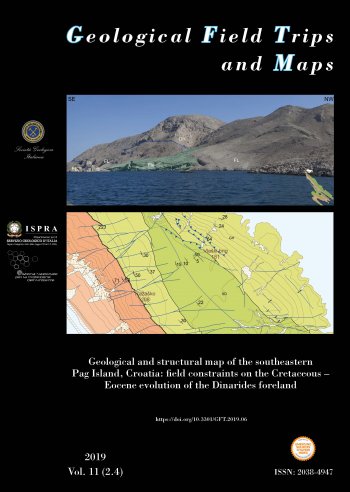
Volume 11 (2.4)/2019
Geological and structural map of the southeastern Pag Island, Croatia: field constraints on the Cretaceous - Eocene evolution of the Dinarides foreland
DOI: https://doi.org/10.3301/GFT.2019.06 - Pages: 1-19
Silvia Mittempergher (1), Andrea Succo (2), Andrea Bistacchi (1), Fabrizio Storti (2), Pierre Olivier Bruna (3) & Marco Meda (4)
(1) - Dipartimento di Scienze dell'Ambiente e della Terra, Università Milano Bicocca, Piazza della Scienza 4, 20126 Milan, Italy.
(2) - NEXT – Natural and Experimental Tectonics research group, Università di Parma, Dipartimento di Scienze Chimiche, della Vita e della Sostenibilità Ambientale, Parco Area delle Scienze 157/A, 43124 Parma, Italy.
(3) - Department of Geoscience and Engineering, Delft University of Technology, Stevinweg 1, 2628 Delft, The Netherlands.
(4) - Eni Spa, Upstream and Technical Services – Piazza Vanoni 1, 20097 San Donato Milanese - Italy.
Corresponding Author e-mail address: silvia.mittempergher@unimib.it
(2) - NEXT – Natural and Experimental Tectonics research group, Università di Parma, Dipartimento di Scienze Chimiche, della Vita e della Sostenibilità Ambientale, Parco Area delle Scienze 157/A, 43124 Parma, Italy.
(3) - Department of Geoscience and Engineering, Delft University of Technology, Stevinweg 1, 2628 Delft, The Netherlands.
(4) - Eni Spa, Upstream and Technical Services – Piazza Vanoni 1, 20097 San Donato Milanese - Italy.
Corresponding Author e-mail address: silvia.mittempergher@unimib.it
Abstract
The sedimentary succession exposed in the Northern Dalmatia Islands mainly consists of Cretaceous to Neogene shallow water carbonates, folded and imbricated within the External Dinarides thrust belt. During Cretaceous times, carbonate sediments were deposed on a heterogeneous, tectonically-influenced carbonate platform, which was then uplifted and eroded, as evidenced by a regional unconformity embracing the Late Cretaceous and Paleocene. Sedimentation resumed during the Eocene, when the area was part of the foreland basin of the Dinaric belt. With our geological and structural map of the southeastern Pag Island at the 1:25,000 scale, we refined the stratigraphic and structural setting and the tectono- sedimentary evolution of the area.
Keywords
